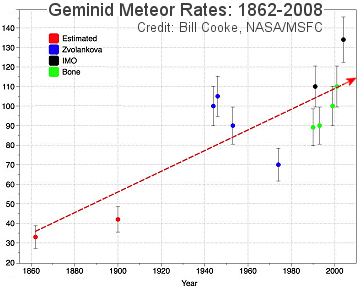The 2009 Geminid Meteor Shower
Posted by
JAC on 12/9/2009, 6:53 am
http://spaceweather.com/meteors/gallery_14dec08_page2.htm

A flurry of Geminids in Dec. 2008 recorded by an all-sky camera at the Marshall Space Flight Center. In the movie, note the circular halo that forms around the Moon as it arcs across the sky; that is caused by ice crystals in high clouds.
http://science.nasa.gov/headlines/y2009/images/geminids2009/msfc1.mov
Make hot cocoa. Bundle up. Tell your friends. The best meteor shower of 2009 is about to fall over North America on a long, cold December night.
"It's the Geminid meteor shower," says Bill Cooke of NASA's Meteoroid Environment Office. "and it will peak on Dec. 13th and 14th under ideal viewing conditions."
A new Moon will keep skies dark for a display that Cooke and others say could top 140 meteors per hour. According to the International Meteor Organization, maximum activity should occur around 12:10 a.m. EST (0510 UT) on Dec. 14th. The peak is broad, however, and the night sky will be rich with Geminids for many hours and perhaps even days around the maximum.
Cooke offers this advice: "Watch the sky during the hours around local midnight. For North Americans, this means Sunday night to Monday morning."
Researchers are interested to see what the Geminids do in 2009. The shower has been intensifying in recent decades and they wonder if the trend will continue.
Geminids are pieces of debris from a strange object called 3200 Phaethon. Long thought to be an asteroid, Phaethon is now classified as an extinct comet. It is, basically, the rocky skeleton of a comet that lost its ice after too many close encounters with the sun. Earth runs into a stream of debris from 3200 Phaethon every year in mid-December, causing meteors to fly from the constellation Gemini:
When the Geminids first appeared in the late 19th century, shortly before the US Civil War, the shower was weak and attracted little attention. There was no hint that it would ever become a major display.
But now it has. "The Geminids are strong-and getting stronger," says Cooke, who has prepared a plot showing how the shower has intensified since its discovery:

HOW STRONG WILL THE GEMINIDS BECOME?
Long ago, on a cold December night in the 19th century, the first Geminid meteors appeared. In those days, the display was so weak (a dozen or so meteors per hour) that only the most alert observers could say they had seen a Geminid. How times have changed. According to data compiled by Bill Cooke of NASA's Meteoroid Environment Office, the Geminid meteor shower has intensified almost five-fold to become one of the best showers of the year:
What's driving the surge? The source of the Geminids is extinct comet 3200 Phaethon. A stream of debris from the comet has been sweeping across Earth's orbit for more than a century, and we are plunging deeper into the stream with each December crossing. Computer models suggest that the Geminids will continue to intensify with meteor rates jumping another 20% to 50% in the decades ahead.
Researchers will be watching the 2009 Geminids to see if the trend does indeed continue. Rates could exceed 140 meteors per hour when the shower peaks on Dec. 13th and 14th.
|
74
In this thread:
The 2009 Geminid Meteor Shower - JAC, 12/9/2009, 6:53 am Post A Reply
This thread has been archived and can no longer receive replies.

